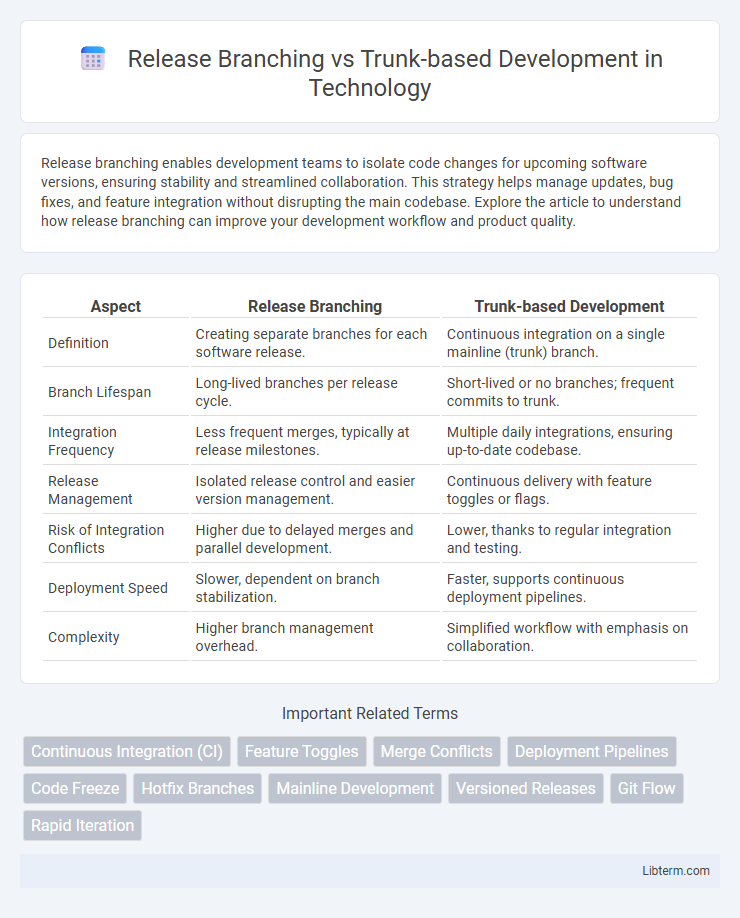Release branching enables development teams to isolate code changes for upcoming software versions, ensuring stability and streamlined collaboration. This strategy helps manage updates, bug fixes, and feature integration without disrupting the main codebase. Explore the article to understand how release branching can improve your development workflow and product quality.
Table of Comparison
| Aspect | Release Branching | Trunk-based Development |
|---|---|---|
| Definition | Creating separate branches for each software release. | Continuous integration on a single mainline (trunk) branch. |
| Branch Lifespan | Long-lived branches per release cycle. | Short-lived or no branches; frequent commits to trunk. |
| Integration Frequency | Less frequent merges, typically at release milestones. | Multiple daily integrations, ensuring up-to-date codebase. |
| Release Management | Isolated release control and easier version management. | Continuous delivery with feature toggles or flags. |
| Risk of Integration Conflicts | Higher due to delayed merges and parallel development. | Lower, thanks to regular integration and testing. |
| Deployment Speed | Slower, dependent on branch stabilization. | Faster, supports continuous deployment pipelines. |
| Complexity | Higher branch management overhead. | Simplified workflow with emphasis on collaboration. |
Introduction to Release Branching and Trunk-based Development
Release Branching involves creating separate branches in version control for each software release, enabling parallel development and targeted bug fixes without disrupting the main codebase. Trunk-based Development emphasizes continuous integration by having developers commit directly to the main branch (trunk), promoting rapid feedback and reducing merge conflicts. Both strategies influence deployment frequency, collaboration, and release management in Agile and DevOps environments.
Key Concepts of Release Branching
Release Branching involves creating separate branches from the main codebase to isolate development for specific product versions, allowing parallel development and targeted bug fixes without destabilizing the main branch. Key concepts include branch isolation, version control, and controlled integration, enabling teams to manage multiple releases simultaneously and maintain code stability. This approach supports scheduled releases and phased feature rollouts, facilitating better quality assurance and deployment strategies.
Fundamentals of Trunk-based Development
Trunk-based development centers on a single main branch where developers integrate small, frequent changes to ensure continuous integration and rapid feedback. This approach minimizes merge conflicts and supports continuous delivery by maintaining a consistently deployable codebase. Teams practicing trunk-based development often use feature toggles to manage incomplete work without branching, enhancing collaboration and reducing release complexity.
Advantages of Release Branching
Release branching enables parallel development by isolating new features from the main codebase, reducing the risk of destabilizing production. This approach provides clear version control and facilitates targeted bug fixes, ensuring more stable and reliable software releases. Enhanced control over release schedules and easier hotfix deployment contribute to improved team productivity and customer satisfaction.
Benefits of Trunk-based Development
Trunk-based development streamlines collaboration by enabling continuous integration and reducing merge conflicts, which accelerates delivery cycles. Developers work on a single shared branch, ensuring faster feedback loops and higher code quality through frequent commits and continuous testing. This approach enhances scalability and agility, making it ideal for modern DevOps and CI/CD workflows.
Common Challenges with Release Branching
Release branching often leads to complex integration issues due to prolonged divergence between branches and the main codebase, increasing merge conflicts and downtime during releases. Maintaining multiple active release branches can cause inconsistent environments and duplicated efforts in testing and bug fixes, hampering overall productivity. Frequent synchronization delays slow down feature delivery and obscure the real-time status of the product, complicating project management and risk assessment.
Potential Drawbacks of Trunk-based Development
Trunk-based development can lead to increased integration conflicts due to multiple developers working on the same codebase simultaneously, complicating coordination and testing efforts. The approach may also result in unstable builds if insufficient feature flagging or continuous integration practices are not rigorously enforced. Furthermore, rapid and frequent merges can overwhelm teams, increasing the risk of introducing bugs and slowing down overall development velocity.
Use Cases: When to Choose Release Branching
Release branching suits projects requiring robust version control and stability for multiple product iterations, such as enterprise software with long maintenance cycles. This approach enables isolated bug fixes and feature freezes while allowing parallel development on the trunk. Teams managing regulated environments or complex release schedules benefit from release branching to ensure consistent production-ready code.
Scenarios Favoring Trunk-based Development
Trunk-based development excels in scenarios requiring continuous integration, rapid feedback, and frequent deployments, making it ideal for agile and DevOps environments. It minimizes merge conflicts and supports collaborative workflows by maintaining a single mainline branch that integrates small, incremental changes. Teams prioritizing fast feature delivery and high code quality benefit from trunk-based development's streamlined process and reduced integration overhead.
Best Practices for Modern Software Version Control
Release branching enables isolated development of features and bug fixes in dedicated branches, ensuring stable production releases while allowing parallel work on new features. Trunk-based development promotes continuous integration by encouraging frequent commits directly to the main branch, reducing merge conflicts and accelerating delivery cycles. Best practices include enforcing automated testing, maintaining short-lived branches in release branching, and implementing feature toggles in trunk-based workflows to manage incomplete features effectively.
Release Branching Infographic

 libterm.com
libterm.com